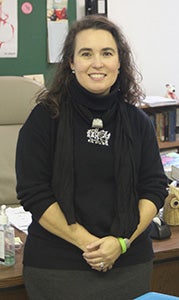Testimony of terror
Published 10:32 pm Thursday, December 4, 2014
When Laura Dobrin read “The Diary of Anne Frank” in the sixth grade, she connected with someone well placed to offer context and perspective.
That person, a friend of her father’s, was a Jew whose family fled Germany in 1933, the year Adolf Hitler rose to the chancellorship.

Nansemond-Suffolk Academy teacher Laura Dobrin has been selected to attend a professional development program in Poland next year that will visit the former Auschwitz concentration and death camp and meet with Holocaust survivors.
When Dobrin started her teaching career in Tennessee, the young Jewish girl’s famous firsthand account of hiding out in Nazi-occupied Europe was the first text she taught.
That reintroduction helped fuel what has become an abiding interest in the Jewish experience during World War II for Dobrin, who now teaches 10th-grade Advanced Placement European history and 12th-grade AP English literature and composition at Nansemond-Suffolk Academy.
“I didn’t know that much about it, so I started learning more and it just gathered from there,” Dobrin said.
Next year, as one of only 25 teachers worldwide selected for a professional development program presented by the USC Shoah Foundation and Discovery Education, Dobrin will travel to Poland to visit the former Nazi concentration and death camp at Auschwitz for the second time in her life.
The program supports the 70th anniversary commemoration of the liberation of Auschwitz, where, according to the United States Holocaust Memorial Museum, more than 960,000 Jews were killed.
“Auschwitz: The Past is Present,” will bring educators from 11 different countries together for a four-day workshop designed to “deepen their understanding of the historical landscape of Poland before, during and after the Holocaust and increase participant knowledge of authentic sites,” according to a news release.
Steven Spielberg founded The University of Southern California-based foundation in 1994 after interviewing Jewish survivors of the Holocaust for his film “Schindler’s List.” The foundation’s IWitness collection contains almost 52,000 video testimonies of genocide.
Program participants in January will work with those testimonies and also meet with Holocaust survivors before attending the commemoration ceremony at Auschwitz-Birkenau State Museum.
“It will probably be the last time they are there, and being able to share that experience with them is going to be very powerful,” Dobrin said of meeting with survivors.
Dobrin previously visited Poland and Auschwitz in 2001. She has also worked with the testimonies twice before, in 2011 and 2012 at USC, and created the first-ever teacher-authored activity in IWitness, on survivor and poet Lotte Kramer.
“It’s one thing to read them, but when you hear someone speaking and see their facial expressions and body language, it gives it another dimension,” Dobrin said.
Dobrin notes that while the big moral lesson out of the Holocaust is “never again,” history keeps repeating: Rwanda, Darfur, Bosnia, Srebrenica — the list keeps growing.
“If students can see and hear and learn these stories, it’s not just millions of people murdered, but millions of individuals,” Dobrin said.
“It’s also realizing they need to be an active citizen. They need to vote, they need to know what’s going on in the world, so they can make a difference.”
As well as a graduate of the foundation’s Teaching with Testimony in the 21st Century program, Dobrin is also a fellow with the U.S. Holocaust Memorial Museum.




